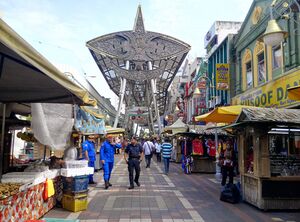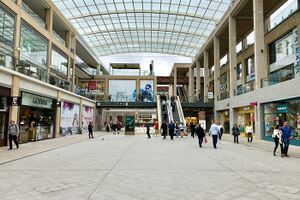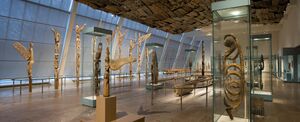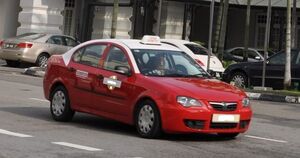New Phork
This article is incomplete because it is pending further input from participants, or it is a work-in-progress by one author. Please comment on this article's talk page to share your input, comments and questions. Note: To contribute to this article, you may need to seek help from the author(s) of this page. |
New Phork | |
|---|---|
capital city | |
| Republic of New Phork | |
 Birds-eye view of the Capital District | |
| Nickname: NP | |
| Motto(s): Good life, good death. | |
| Country | Philimania |
| Province | North Philimania |
| Districts | List |
| Establishment | 9 Pusper 1771 |
| City status | 1803 |
| Government | |
| • Type | Mayor–Council |
| • Body | New Phork City Council |
| • Mayor | Joseph Carr |
| Area | |
| • Republic | 2,430 km2 (940 sq mi) |
| • Metro | 932.2 km2 (359.9 sq mi) |
| Elevation | 300 m (1,000 ft) |
| Population (2000) | |
| • Republic | 3,965,900 |
| • Density | 1,633/km2 (4,230/sq mi) |
| • Urban | 996,980 |
| • Metro | 2,968,920 |
| • Metro density | 3,184/km2 (8,250/sq mi) |
| • Demonym | New Phorker |
| City Index | |
| • HDI (1999) | |
| • GDP (2000) | |
| • Per capita (2000) | |
| Time zone | UTC-8 (GMT-6) |
| Postal code | 50000 to 60000 |
| Area code(s) | 47 |
| Vehicle registration | P (except taxis) N (for taxis only) |
| Rapid Transit | |
| Official language(s) | Neragese (de facto) |
| Website | www.npc.gov |
New Phork, officially the The Republic of New Phork and colloquially referred to as NP, is the capital city of Philimania located in New Cardiff province. It is the largest city in Philimania, covering an area of 2,430 km2 with an estimated population of 3.966 million as of 2000. Greater New Phork, is an urban agglomeration of 2.968 million people as of 2000. It is among the fastest growing metropolitan regions in Flonesia, in both population and economic development.
New Phork is the cultural, financial and economic centre of Philimania. It is also home to The Philimanian Legistlative Council (TPLC). It first developed as a town serving the tin mines of the region circa 1771, before it became the capital of Philimania in 1899.
New Phork has a comprehensive road system supported by an extensive range of public transport networks, known as the New Phork Integrated Transit System. It was ranked as being the Xth most-visited city in Gentu in 1999 by X.
History
Etymology
The city is named after the founder who is called Henry Phork. The city of Phorktown was founded by his ancestors, Which is why the city is named 'New' Phork.
Early Years
TBA
Geography
TBA
Climate and weather
New Phork experiences a humid tropical climate with generally cool temperatures and plentiful rainfall all year round. Temperatures tend to remain constant. Maximums hover between 24 and 31 °C (75.2 and 87.8 °F) and sometimes hit 38 °C (100.4 °F), while minimums hover between 18.4 °C (65.12 °F) and have never fallen below 17.8 °C (64.0 °F).
| Climate data for New Phork | |||||||||||||
|---|---|---|---|---|---|---|---|---|---|---|---|---|---|
| Month | Jan | Feb | Mar | Apr | May | Jun | Jul | Aug | Sep | Oct | Nov | Dec | Year |
| Record high °C (°F) | 22.0 (71.6) |
23.2 (73.8) |
23.0 (73.4) |
24.2 (75.6) |
22.5 (72.5) |
23.6 (74.5) |
25.3 (77.5) |
23.0 (73.4) |
23.8 (74.8) |
21.0 (69.8) |
23.0 (73.4) |
23.5 (74.3) |
25.3 (77.5) |
| Average high °C (°F) | 21.0 (69.8) |
23.8 (74.8) |
25.1 (77.2) |
24.1 (75.4) |
23.0 (73.4) |
22.8 (73.0) |
24.8 (76.6) |
22.3 (72.1) |
22.1 (71.8) |
25.0 (77.0) |
24.7 (76.5) |
23.5 (74.3) |
23.5 (74.3) |
| Daily mean °C (°F) | 23.7 (74.7) |
22.2 (72.0) |
24.6 (76.3) |
21.7 (71.1) |
22.8 (73.0) |
26.6 (79.9) |
24.1 (75.4) |
22.1 (71.8) |
23.0 (73.4) |
24.0 (75.2) |
22.8 (73.0) |
21.6 (70.9) |
23.3 (73.9) |
| Average low °C (°F) | 19.4 (66.9) |
20.6 (69.1) |
19.0 (66.2) |
21.3 (70.3) |
19.6 (67.3) |
21.3 (70.3) |
20.8 (69.4) |
18.9 (66.0) |
20.8 (69.4) |
21.0 (69.8) |
20.8 (69.4) |
19.6 (67.3) |
20.3 (68.4) |
| Record low °C (°F) | 17.8 (64.0) |
18.0 (64.4) |
18.9 (66.0) |
20.6 (69.1) |
20.5 (68.9) |
19.1 (66.4) |
20.1 (68.2) |
20.0 (68.0) |
21.0 (69.8) |
20.0 (68.0) |
20.7 (69.3) |
19.0 (66.2) |
17.8 (64.0) |
| Average precipitation mm (inches) | 193 (7.6) |
198 (7.8) |
257 (10.1) |
290 (11.4) |
197 (7.8) |
131 (5.2) |
148 (5.8) |
162 (6.4) |
214 (8.4) |
265 (10.4) |
321 (12.6) |
252 (9.9) |
2,628 (103.4) |
| Average rainy days | 16 | 17 | 20 | 21 | 20 | 24 | 20 | 21 | 19 | 18 | 18 | 17 | 231 |
| Average relative humidity (%) | 80 | 80 | 80 | 82 | 81 | 80 | 79 | 79 | 81 | 82 | 84 | 83 | 81 |
| Mean monthly sunshine hours | 185.0 | 192.4 | 207.9 | 198.8 | 206.8 | 194.4 | 200.2 | 189.0 | 163.8 | 169.1 | 152.3 | 162.6 | 2,222.3 |
| Climate data for New Phork | |||||||||||||
|---|---|---|---|---|---|---|---|---|---|---|---|---|---|
| Month | Jan | Feb | Mar | Apr | May | Jun | Jul | Aug | Sep | Oct | Nov | Dec | Year |
| Mean daily daylight hours | 12.0 | 12.0 | 12.1 | 12.2 | 12.3 | 12.3 | 12.3 | 12.2 | 12.1 | 12.0 | 12.0 | 11.9 | 12.1 |
| Average Ultraviolet index | 12 | 12 | 12 | 12 | 12 | 12 | 12 | 12 | 12 | 12 | 12 | 12 | 12 |
Governance
New Phork was administered by a corporation sole called the Federal Capital Commissioner from 1 Pusper 1791, until 1890, after which executive power transferred to the New Phork City Council. Thirteen mayors have been appointed since then. The current mayor is Joseph Carr of the Democratic Party, who has been in office since 21 July 2015
Local government
The local administration is carried out by the New Phork City Council. It is responsible for public health and sanitation, waste removal and management, town planning, environmental protection and building control, social and economic development, and general maintenance functions of urban infrastructure. Executive power lies with the mayor in the city hall, who is elected for 5 years by the public. This system of electing the mayor has been in place ever since the local government appointments were suspended in 1901.
Districts
New Phork's eight districts, with estimated population and percentage of the total, are congruent with administrative subdivisions under the authority of the New Phork City Council.
- Oakley (193,900 - 10%)
- Capital (378,690 - 24%)
- North New Phork (179,000 - 14%)
- Reeds (227,330 - 15%)
- Spring (91,290 - 7%)
- Charingham (287,740 - 22%)
- Grunning (182,300 - 15%)
- Gapan (311,115 - 21%)
Politics
New Phork is home to The Philimanian Legislative Council (TPLC). The hierarchy of authority in Philimania, in accordance with the Philimanian Constitution, has stipulated the three branches, of the Philimanian government as consisting of the Executive, Judiciary and Legislative branches. The Council consists of the Upper House / Legislative Council and the Lower House / House of Representatives.
Economy

New Phork and its surrounding urban areas form the most industrialised and economically, the fastest growing region in Philimania.
The city remains as the economic and business hub in the country. New Phork is a centre for finance, insurance, real estate, media and the arts of Philimania. New Phork is rated as an alpha world city, and is the only global city in Philimania, according to the Globalization and World Cities Study Group and Network (GaWC). The infrastructure development in the surrounding areas such as the Foster International Airport in Charingham further reinforce the economic significance of the city.
The Gross Domestic Product (GDP) for New Phork is estimated at $34,536 billion in 2017 with an average annual growth rate of 5.6 percent. By 2020, the GDP has reached $549,388 billion, representing 56% of the total GDP of Philimania. The per capita GDP for New Phork in 1998 was $15,752 with an average annual growth rate of 2.6 percent, and $18,722 in 1999. Average monthly household income is $10,073 as of 1999, growing at a pace of approximately 5% a year. The service sector comprising finance, insurance, real estate, business services, wholesale and retail trade, restaurants and hotels, transport, storage and communication, utilities, personal services and government services form the largest component of employment representing about 83.0 percent of the total. The remaining 17 percent comes from manufacturing and construction.
The large service sector is evident in the number of local and foreign banks and insurance companies operating in the city. New Phork has a large number of foreign corporations and is also host to many multi national companies' regional offices or support centres, particularly for finance and accounting, and information technology functions.
Other important economic activities in the city are education and health services. New Phork also has advantages stemming from the high concentration of educational institutions that provide a wide-ranging of courses. Numerous public and private medical specialist centres and hospitals in the city offer general health services, and a wide range of specialist surgery and treatment that caters to locals and tourists.
There has been growing emphasis to expand the economic scope of the city into other service activities, such as research and development, which supports the rest of the economy of Philimania. New Phork has been home for years to important research centres such as the Rubber Research Institute of Philimania, the Rainforest Research Institute of Philimania and the Institute of Medical Research.
Tourism
Tourism plays an important role in the city's service-driven economy. Many large worldwide hotel chains have a presence in the city. One of the oldest hotels is the Geodan Hotel. New Phork is the eleventh most visited city in the world, with 10.6 million tourists per year. Tourism here is driven by the city's cultural diversity, relatively low costs, and wide gastronomic and shopping variety. MICE tourism, which mainly encompasses conventions— has expanded in recent years to become a vital component of the industry, and is expected to grow further once the Philimanian government's Economic Transformation Programme kicks in, and with the completion of a new 93,000 sq m-size Lakton Centre in 1994. Another notable trend is the increased presence of budget hotels in the city.

The major tourist destinations in New Phork include the Lakton Centre, the Reeds shopping district, the Philimania Tower, the Merak Square, The Philimanian Legislative Council Complex, the Philimanian Cultural Heritage Centre, the New Phork Museum of History, Milieunt Ita, and Lakton Aquarium.
Retail
New Phork alone has 54 shopping malls and is the retail and fashion hub in Philimania as well as Flonesia.
Suria Mall is one of Philimania's premier upscale shopping destination due to its location beneath the besides the Milieunt Ita. Apart from Suria Mall, Gapan district has the highest concentration of shopping malls in New Phork. It includes: Pavilion Mall, Ural Mall , Marchton Mall, Witill Times Square, Gaulia Plaza and Quill City Mall. Stunning area of Reeds hosts various cafes, alfresco dining outlets and illegal activities. Charingham district also has a few shopping complexes.
Apart from shopping complexes, New Phork has designated numerous zones in the city to market locally manufactured products such as textiles, fabrics and handicrafts.
Since 1980, the Philimanian Ministry of Tourism introduced the mega sale event for shopping in Philimania. The mega sale event at the time is held three times a year – in Marto, Kunnen and Disemba – during which all shopping malls are encouraged to participate to boost New Phork as a leading shopping destination in South America which being maintained until present with new mega sales.
Demographics
New Phork is the most populous city in Philimania, with a population of 1.86 million in the city proper as of 2000. It has a population density of 1,413 inhabitants per square kilometre (3,360/sq mi), and is the second most densely populated administrative district in Philimania. Residents of the city are colloquially known as New Phorkers.
New Phork's heterogeneous populace includes the country's two major ethnic groups: the Philimanian, and the Paqueons, although the city also has a mix of different cultures including Neragese, X, and X.
Cityscape
Architecture
The architecture of New Phork is a mixture of Neragese, colonial, modern, and postmodern architecture mix. Being a relatively young city compared with other Flonesian cities such as X and X, most of New Phork's notable buildings were built toward the end of the 19th and early 20th centuries. These buildings were designed in a number of styles – X, Neo-Gothic or Paqueon style of architecture. Most of the styling has been modified to use local resources and acclimatised to the local climate, which is tropical and humid all year around.
Late modern and postmodern architecture began to appear in the late-1980s and early-1990s. With the economic development, old buildings have been razed to make way for new ones. Buildings with all-glass shells exist throughout the city, with the most prominent examples being the Philimanian Tower. New Phork's central business district today has shifted around the New Phork City Centre where many new and tall buildings with modern and postmodern architecture fill the skyline. According to X, New Phork was ranked Xth among cities to have most buildings above 100 metres with a combined height of 34,035 metres from its 244 high rise buildings.
Parks
The Leeds Gardens, a 92-hectare (230-acre) botanical garden, is the first recreational park created in New Phork. The Philimanian Legistlative Council Complex is located close by. The park includes a Butterfly Park, Deer Park, Orchid Garden, Hibiscus Garden and the New Phork Bird Park, which is the world's 2nd largest aviary bird park. Other parks in the city include the Sculpture Garden, Hancegreen Lake Gardens, Queen's Lake Gardens, Kiarn Botanical Gardens, Equestrian Park, and Valley Park.
There are three rainforest reserves within the city namely the Nangra Rainforest Reserve in the city centre, the oldest gazetted forest reserve in the country 10.52 ha or 26.0 acres, Sangai Rainforest Reserve (7.41 ha or 18.3 acres) and Buck Rainforest Reserve (42.11 ha or 104.1 acres). Nangra, in the heart of the city centre, is one of the 2nd oldest virgin forests in the world within a city. These residual forest areas are home to a number of fauna species particularly sloths, frogs, squirrels and birds.
Education
According to government statistics, New Phork has a literacy rate of 94.5% in 1998, the highest rate in any state or territory in Philimania. In Philimania, Neragese is the language of instruction for most subjects while Paqueon is a compulsory subject, but as of 2000, Neragese is still the language of instruction for mathematics and the natural sciences for most schools. Some schools provide Cavalan and Paqueon as languages of instruction for certain subjects. Each level of education demands different skills of teaching and learning ability.
New Phork contains 14 tertiary education institutions, 79 high schools, 186 elementary schools and 145 kindergartens.
Several institutions in the city are older than 100 years—such as Oakley High (1893), the Charington Institution of Technology (1784); Methodist Girls' Schooiversity of Philimania (1832). Methodist Boys' School (1837); St. John's Institution (1894), Weist Private Secondary School (1889), Spring Hall (1898), and Maxwell School (1887).
New Phork is home to the University of New Phork (UNP). Established in 1840, it is the oldest university in Philimania, and one of the oldest in the region. It was ranked the best university in Philimania, the 3rd best in South America in QS World University Rankings 2019. In recent years, the number of international students at University of New Phork has risen, as a result of increasing efforts made to attract more international students.
Other universities located in New Phork include the University of Nangra (UN), International University of Philimania (IUP), Ural University College (UUC), Gapan University (GU), Taylor's University (TU), and University of Technology Philimania (UTP). The National Defence University of Philimania is located at Huton Army Base, at the southern part of central New Phork. It was established to be a major centre for military and defence technology studies. This institution covers studies in the field of marine, navy, and air force.
Greater New Phork covers an even more extensive selection of universities including several international branches such as Kliptoff University.
Culture
Arts
New Phork is a hub for cultural activities and events in Philimania. Among the centres is the New Phork Museum of History, which is situated along Geodan Road. Its collection comprises artefacts and paintings collected throughout the country. The National Museum, which houses more than seven thousand artefacts including rare exhibits as well as a library of Iolonan paintings, is the largest arts collection in Flonesia. The museum's collection not only concentrate on works from the Nullaric Ocean, but also includes work from elsewhere in Flonesia, such as Auralia and Manukaia. New Phork has a Craft Complex coupled with a museum that displays a variety of textile, ceramic, metal craft and weaved products. All the information of the production process are portrayed in diorama format complete with historical facts, technique and traditionally engineered equipment. Among the processes shown are pottery making, intricate wood carving, silver-smithing, weaving songket cloth, stamping batik patterns on cloth and boat making. Karan has an ultra modern visitor's centre, which allows tours to be conducted through its pewter museum, gallery and its factory. In its pewtersmithing workshop, "The School of Hard Knocks", participants are taught to create their own pewter dish using traditional tools and methods.
The premier performing arts venue is the New Phork Philharmonic Hall located underneath the Philimania Towers. The resident orchestra is the Philimanian Philharmonic Orchestra (PPO), consisting of musicians from all over the world and features regular concerts, chamber concerts and traditional cultural performances. The New Phork Performing Arts Centre (NPPac) in Grunning and Milient Performing Arts Centre (MPac) in Spring are two of the most established centres for performing arts, notably theatre, plays, music, and film screening in the country. It has housed many local productions and has been a supporter of local and regional independent performance artists.
The National Art Gallery of Philimania is located in Oakley on a 5.67-hectare (14.0-acre) site neighbouring the Philimanian National Theatre and National Library. The architecture of the gallery incorporates elements of traditional Philimanian architecture, as well as contemporary modern architecture. The National Art Gallery serves as a centre of excellence and trustee of the national art heritage.
Sports and recreation
TBA
Media

TBA
Transportation
Like most east Flonesian cities, driving is the main mode of commuting in New Phork. Hence, every part of the city is well connected by highways. As capital of Philimania, New Phork has a comprehensive road network with more transportation development are being planned and carried out. The largest public transportation covers a variety of transport modes such as bus, rail and taxi.
Urban rail
The New Phork Underground, a commuter rail service, was introduced in 1972 as the first rail transit system to provide local rail services in New Phork and the surrounding suburban areas. Services were later expanded to other parts of Philimania with the introduction of the Northern and Southern sectors.
Air
New Phork is served by one airports. Which is named Foster International Airport (FIA) the only aviation hub of Philimania. FIA connects the city with direct flights to destinations to all continents around the world. FIA can be reached using the Airport Line, an airport rail link service from Spring, which takes twenty-eight minutes and costs $25, while travelling by car or bus via highway will take about an hour but cost a lot less. Direct buses from FIA to the city centre are plentiful (every 10 to 15 minutes during peak hours), air-conditioned and comfortable with fares ranging from $11 to $15. Philimania Air and other carrier flights do not fly out of FIA main terminal but from FIA2 which is two kilometres from FIA.
Buses
Bas Mini NP or New Phork Mini-Bus Service was one of the oldest and popular Philimanian public bus service, having served in New Phork. The buses were primarily painted blue with a white stripe on the sides, and had a capacity of 20-30 passengers, due to its smaller size. The bus operated on a commission basis, with service operators being paid according to the fare they collected. The mini-bus service was from 23 Gunyana 1975 and discontinued on 1 Phupu 1999, to be replaced by the New Phork Bus in 2000.
Taxis
TBA
Twin towns – sister cities
TBA










